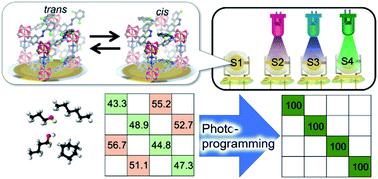当前位置:
X-MOL 学术
›
Chem. Sci.
›
论文详情
Our official English website, www.x-mol.net, welcomes your
feedback! (Note: you will need to create a separate account there.)
A photoprogrammable electronic nose with switchable selectivity for VOCs using MOF films
Chemical Science ( IF 7.6 ) Pub Date : 2021-11-22 , DOI: 10.1039/d1sc05249g Peng Qin 1 , Salih Okur 1 , Chun Li 1 , Abhinav Chandresh 1 , Dragos Mutruc 2 , Stefan Hecht 2, 3, 4 , Lars Heinke 1
Chemical Science ( IF 7.6 ) Pub Date : 2021-11-22 , DOI: 10.1039/d1sc05249g Peng Qin 1 , Salih Okur 1 , Chun Li 1 , Abhinav Chandresh 1 , Dragos Mutruc 2 , Stefan Hecht 2, 3, 4 , Lars Heinke 1
Affiliation

|
Advanced analytical applications require smart materials and sensor systems that are able to adapt or be configured to specific tasks. Based on reversible photochemistry in nanoporous materials, we present a sensor array with a selectivity that is reversibly controlled by light irradiation. The active material of the sensor array, or electronic nose (e-nose), is based on metal–organic frameworks (MOFs) with photoresponsive fluorinated azobenzene groups that can be optically switched between their trans and cis state. By irradiation with light of different wavelengths, the trans–cis ratio can be modulated. Here we use four trans–cis values as defined states and employ a four-channel quartz-crystal microbalance for gravimetrically monitoring the molecular uptake by the MOF films. We apply the photoprogrammable e-nose to the sensing of different volatile organic compounds (VOCs) and analyze the sensor array data with simple machine-learning algorithms. When the sensor array is in a state with all sensors either in the same trans- or cis-rich state, cross-sensitivity between the analytes occurs and the classification accuracy is not ideal. Remarkably, the VOC molecules between which the sensor array shows cross-sensitivity vary by switching the entire sensor array from trans to cis. By selectively programming the e-nose with light of different colors, each sensor exhibits a different isomer ratio and thus a different VOC affinity, based on the polarity difference between the trans- and cis-azobenzenes. In such photoprogrammed state, the cross-sensitivity is reduced and the selectivity is enhanced, so that the e-nose can perfectly identify the tested VOCs. This work demonstrates for the first time the potential of photoswitchable and thus optically configurable materials as active sensing material in an e-nose for intelligent molecular sensing. The concept is not limited to QCM-based azobenzene-MOF sensors and can also be applied to diverse sensing materials and photoswitches.
中文翻译:

使用 MOF 薄膜对 VOC 具有可切换选择性的光可编程电子鼻
先进的分析应用需要能够适应或配置特定任务的智能材料和传感器系统。基于纳米多孔材料中的可逆光化学,我们提出了一种传感器阵列,其选择性可由光照射可逆控制。传感器阵列或电子鼻(e-nose)的活性材料基于具有光响应氟化偶氮苯基团的金属有机框架(MOF),可以在反式和顺式状态之间进行光学切换。通过不同波长的光照射,可以调节反式-顺式比率。在这里,我们使用四个反式-顺式值作为定义的状态,并采用四通道石英晶体微天平通过重力监测 MOF 薄膜的分子吸收。我们将光可编程电子鼻应用于不同挥发性有机化合物(VOC)的传感,并使用简单的机器学习算法分析传感器阵列数据。当传感器阵列处于所有传感器都处于相同反式或顺式富集状态的状态时,分析物之间会出现交叉敏感性,并且分类精度不理想。值得注意的是,传感器阵列之间表现出交叉敏感性的 VOC 分子会随着整个传感器阵列从反式切换为顺式而变化。通过用不同颜色的光选择性地对电子鼻进行编程,每个传感器根据反式和顺式偶氮苯之间的极性差异,表现出不同的异构体比例,从而表现出不同的 VOC 亲和力。在这种光编程状态下,交叉敏感性降低,选择性增强,使电子鼻能够完美识别被测VOC。这项工作首次证明了光可切换材料和光学可配置材料作为电子鼻中用于智能分子传感的活性传感材料的潜力。该概念不仅限于基于 QCM 的偶氮苯-MOF 传感器,还可以应用于各种传感材料和光电开关。
更新日期:2021-11-22
中文翻译:

使用 MOF 薄膜对 VOC 具有可切换选择性的光可编程电子鼻
先进的分析应用需要能够适应或配置特定任务的智能材料和传感器系统。基于纳米多孔材料中的可逆光化学,我们提出了一种传感器阵列,其选择性可由光照射可逆控制。传感器阵列或电子鼻(e-nose)的活性材料基于具有光响应氟化偶氮苯基团的金属有机框架(MOF),可以在反式和顺式状态之间进行光学切换。通过不同波长的光照射,可以调节反式-顺式比率。在这里,我们使用四个反式-顺式值作为定义的状态,并采用四通道石英晶体微天平通过重力监测 MOF 薄膜的分子吸收。我们将光可编程电子鼻应用于不同挥发性有机化合物(VOC)的传感,并使用简单的机器学习算法分析传感器阵列数据。当传感器阵列处于所有传感器都处于相同反式或顺式富集状态的状态时,分析物之间会出现交叉敏感性,并且分类精度不理想。值得注意的是,传感器阵列之间表现出交叉敏感性的 VOC 分子会随着整个传感器阵列从反式切换为顺式而变化。通过用不同颜色的光选择性地对电子鼻进行编程,每个传感器根据反式和顺式偶氮苯之间的极性差异,表现出不同的异构体比例,从而表现出不同的 VOC 亲和力。在这种光编程状态下,交叉敏感性降低,选择性增强,使电子鼻能够完美识别被测VOC。这项工作首次证明了光可切换材料和光学可配置材料作为电子鼻中用于智能分子传感的活性传感材料的潜力。该概念不仅限于基于 QCM 的偶氮苯-MOF 传感器,还可以应用于各种传感材料和光电开关。









































 京公网安备 11010802027423号
京公网安备 11010802027423号